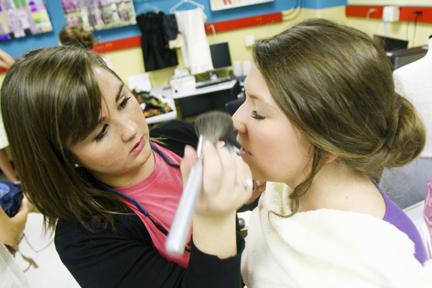The third annual fashion show for senior fashion development students, held Thursday in the College of Textiles courtyard at 8 p.m., showcased the semester-long work of 21 designers, taught by associate professor of fashion and textile management Cynthia Istook.
During the course of the semester, Istook worked individually with the students in creating their collections.
”We negotiated what they had to do, and there were criticisms where advice of what to change or fix was given,” Istook said.
Istook said despite her involvement, the garments seen were all the students’ designs.
A wide range of preparations was needed to ensure the night would be a success. For the designers, tasks ranged from finding people to do hair and make-up to booking models with a fierce strut. The Student and Career Services office sold tickets and students volunteered to sell tickets on the night of the show. A facilities crew worked with some students to construct the runway over the reflecting pool.
The College of Textiles set up the catwalk in the courtyard of the college. Luminaries lined the sidewalk and a platform jutted out into the middle of the reflecting pond. Strings of white lights were draped around the sides, and assistants were seen placing votive candles in the water to be lit later in the night. As the lights went down, strings of lights around the catwalk and lights positioned on the side of the pond facing the runway were switched on.
Designs ranged from one end of the spectrum to another.
Emily Robbins, a senior in fashion and textile management, showed a collection of night wear — her models sporting baby-doll bows in their hair, some of which were dressed up in 1960s bouffants and flips. Her collection featured baby-doll dresses with empire waists, loose v-neck tops, and pajama pants in hues of white, pink and green.
Kelley Loeffler, a senior in textile and apparel management, created her own floral designs using the College of Textiles digital design lab. Her silhouettes were inspired by the 1950s, and her collection featured many bell skirts that held their shape. Her designs also paid tribute to modernity in ways such as a dress having contrasting colors inserted in its sides. Loeffler’s models made their appearances on the runway while balancing plates of cupcakes on their palms.
Mor Aframian, a senior in textile and apparel management, was the only designer to design a full line of menswear. Her collection, entitled “License to Kill”, embodied clothes for a cool and confident man. Many shirts were button-down, with a contrasting blue or tan panel over the back yoke of the shirt.
”I wanted to do something different that was challenging, and I wanted to focus on how to put garments together correctly,” Aframian said.
After each designer had shown their collection, Istook thanked certain designers who had helped put together the show. Each designer was also brought back onstage with a model while the audience voted for their favorite for the people’s choice award. The categories for prizes were casual, day wear, cocktail and evening wear, and each category had a $200 runner-up and $500 first prize.
For casual wear, Cherihan Lusk, fashion and textile management, was the runner-up and Kim Ray, a senior in textile and apparel management, won first place. Katie McCree, textile and apparel management, was the runner-up in day wear and Mor Aframian took first place. For cocktail attire, Laurel Saunders, senior in textile and apparel management, was the runner-up, while Caroline Cockerham, senior in textile and apparel management, won first place. In evening wear, Amy Mathys, senior in textile and apparel management, was the runner-up, and Katrina Kaplanis, senior in textile and apparel management, took first place.
”Winning was a really good surprise, since I’ve never won anything,” Aframian said.
Kaplanis also won best in show from the panel of judges, and earned an $800 prize. For peoples’ choice, Caroline Cockerham scored another win, adding another $500 prize to her previous prize.
Cockerham’s collection showed many oversized details, such as a rosette that covered the bodice of one dress and an oversized angled bow on another dress.
Kaplanis’ designs revolved around flowers and used the motif of white rosettes throughout her collection. She began her collection by creating all the white rosettes by hand, as well as painted roses and scanned them into a computer program to create her printed fabric.
”I worked until today. I was still stitching rosettes on a dress earlier,” Kaplanis said.
Kaplanis said that she was excited and happy about her work being recognized.
”I didn’t expect to be in evening wear, and also to win best in show. But even if I hadn’t won, it still would have been fun,” Kaplanis said.








